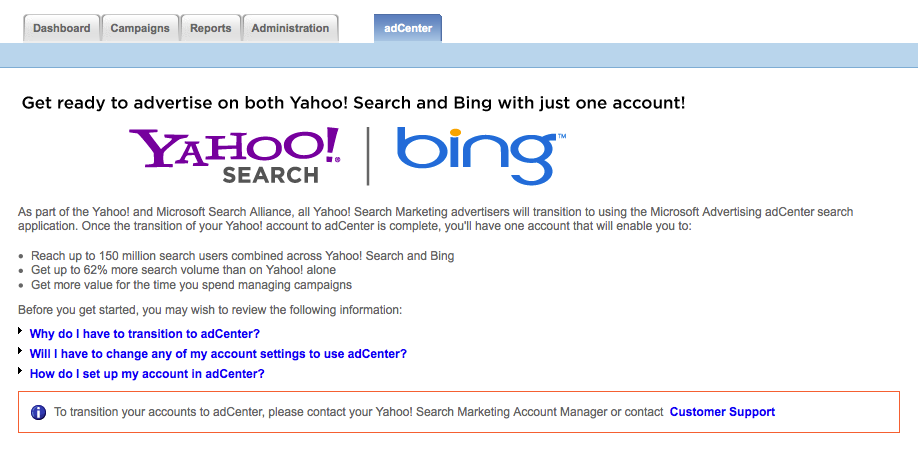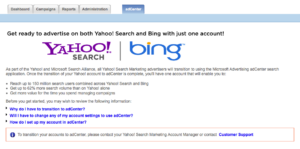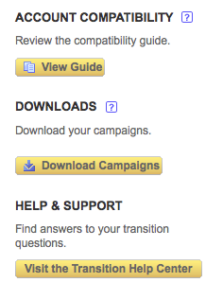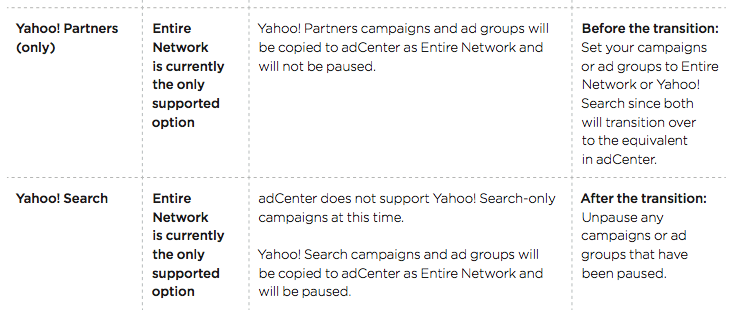We all know it’s coming. Some of us are excited while some of us wish it weren’t so. It’s certainly the biggest news in PPC marketing since…I dunno…AdWords? It’s tough to finally say it, but Yahoo and Bing are combining in, what they’re calling, “the Yahoo! And Microsoft Search Alliance.” I guess that wasn’t as scary as I thought. As they say, admitting is the first step. The real question is, what’s the next step and when should I get started? To answer those questions bluntly, the next step is to transition your yahoo account into MSN and you should get started (at least in educating yourself) now if you haven’t already. I realize that answer doesn’t help get the job done but I’m treating this article mostly as a resource center but partially as a classroom to help. There is simply too much information to summarize in one or even several blog posts but at least I can get the ball rolling, point you in the right direction, and ease some concerns you might have.
You might be asking yourself if you have a need for this information. Truthfully, it depends on what engines you’re currently working on. Basically, if you are running PPC on Yahoo or Bing, then pay attention. If you haven’t ventured into these PPC markets but are interested in doing so, read on to help understand the alliance. If you couldn’t care less about these engines but do work with AdWords, there is still some value in understanding how competing markets are changing. Honestly, the information is important to anyone advertising with search engines, just more so if you’re using Yahoo or Microsoft.
If you’ve signed into a Yahoo account in the past day or so, you’ve probably noticed something new. If the picture below doesn’t ring any bells, you’re guilty of ignoring your yahoo account.
This tab is Yahoo’s obvious way of reminding their current users to transition their account. Hopefully, by this point you can agree that this is a necessary evil. The next step is understanding the alliance. My recommendation is utilizing the resources provided from the source. Start with the Search Alliance homepage. Outside of taking the time to explain the reasoning behind the move, it’s also a great hub for additional resources. Yahoo has it’s own Transition Center page and coincidentally, there is a Microsoft Transition Center as well. I honestly feel that those are the best sources for understanding the change and the sites aren’t so deep that you can’t read through them quickly. There is no doubt that this transition is going to take some of your valuable time on the front end but in the end, you’ll have one less account to manage (yay!).
In addition to the pages from Yahoo and Microsoft, there are plenty of articles out there to help educate yourself on the topic (you’re reading one now). Check out our PPC Roundups over the past several weeks. I’ve been pointing out some great articles on the topic. In particular, the one in the previous link talks about how your bid strategy might (should) change.
Moving on in our transition, it’s time we start talking about the differences you’ll want to take note of. Yahoo has supplied a great document that has all the details you’ll need to understand the differences. To download it, sign into your Yahoo account, go to the adCenter tab shown above, and it will be on towards the right side of the screen. I’ve included a screen cap so you know what you’re looking for.
The document lists a number of changes that you will need/want to take note of. This will be of particular importance if you don’t have much experience working with Microsoft adCenter. First and foremost, there are a number of Yahoo elements that will not be supported in the adCenter interface. To hit on some examples of what won’t be coming with your Yahoo account, here’s a brief list:
Master Account Users (for those of you new to adCenter), Campaign Optimization, Content Match Budget Allocation, the Watch List, Ad Names, Long Descriptions, Enhanced Tracking Parameters, Age Bid Adjustments, Underage Blocking, Male/Female Bid Adjustments, Daypart Bid Adjustments, and Zip Code Level.
I highly recommend reading this document. In addition to pointing out the aspects you’ll lose in the transition, there are a number of recommended actions that should be taken before AND after you move your account. I’ve included a couple examples here to give you an idea as to what I’m talking about.
Hopefully you can see why this document is so important in helping with an effective transition. The only way for me to replicate that information would be to type it out word for work and I’m not a big fan of plagiarism.
So now that your account is prepped and you’re ready for the move, what do you do? It’s really not that difficult at all. If you go back to the adCenter tab in your Yahoo account, the second tool below the compatibility guide is a simple account download option. That tool will allow you to easily download your yahoo account so it can later be uploaded into adCenter – hopefully after you’ve taken the recommended precautions (last reminder to read the compatibility document).
Once you’ve got your campaign template from yahoo it can easily be uploaded into adCenter. If you don’t already have a Microsoft account, the first step is creating one. Once you login to Microsoft adCenter you should notice a “Getting Started” box towards the lower right portion of your screen. In that box is an option to import campaigns from Yahoo. Importing the account will be fairly straightforward, just follow the on screen prompts. Once you’re import has taken place, remember to go back to the compatibility guide to reference the items that are recommended to take place after the transition. Congratulations, you’re now advertising on the combined network!
I think the key component of making the transition a smooth one, is understanding why it is taking place and the primary differences in the accounts. I believe the alliance will be a good for everyone involved. I know I will really appreciate having one less interface to manage. Plus, the additional market reach for your time investment is outstanding. The only real gripe I have is that my office uses Apple computers so we’ll be fighting over remote use to desktop editor on our lone PC (unfortunately Microsoft Editor isn’t Mac compatible). Without knocking the PC folks out there, I really hope Microsoft Editor gets Mac compatible before the transition is complete. If not, it will be a bittersweet change around these parts.







